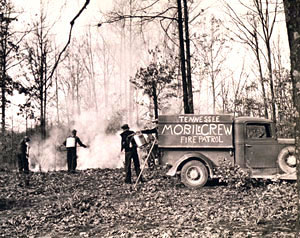
Tennessee State Forests
Although recommended as early as the 1870s, a state forest system received its first impetus in 1900 when President William McKinley asked for a report on the natural resources of the Southern Appalachians, including Tennessee. In response to the report’s recommendations, the Tennessee General Assembly approved establishment of three federal reserves in Tennessee: the Unaka, Pisgah, and Cherokee, later to be combined into the Cherokee National Forest.
In 1905 the general assembly created a Department of Game, Fish, and Forestry; the state’s first general forestry law was passed in 1907. In 1914 the position of state forester was established in the Tennessee Geological Survey agency. The Division of Forestry, created in 1915, remained under the survey until 1921 when the state created the Bureau of Forestry and a State Forestry Commission within the Tennessee Department of Agriculture. It also made the teaching of forestry mandatory in public schools. In 1923 the establishment of the state’s first forestry school at the University of the South aided the training of foresters. The University of Tennessee began offering courses and created a four-year degree program in 1936. The first state forest was established in 1927 in Madison County on thirty-eight acres donated by the county from tax-delinquent lands.
The denuded hillsides and the erosion that were the legacies of the timber boom of the 1870s through the 1920s received no attention until the Civilian Conservation Corps (CCC) began reforestation and soil conservation projects in the 1930s. In 1933 CCC crews established Morgan (now Lone Mountain in Morgan County with 3,597 acres), Bledsoe (on 6,656 acres in Cumberland, White, Van Buren, and Bledsoe Counties), and Pickett (15,887 acres in Pickett County) State Forests. In 1935 to 1940 the CCC created Grundy (now part of the South Cumberland State Recreation Area); Stewart (4,000 acres in Stewart County); Lewis (1,257 acres in Lewis County); Franklin-Marion (6,941 acres in its namesake counties); and Scott (3,182 acres in Scott and Fentress Counties) State Forests. After planting more than 63 million trees and 554,457 pounds of hardwood seeds in these forests and other areas, the CCC began a reforestation project in the Copper Basin in 1941, but the project was interrupted by World War II. In the 1930s the Tennessee Valley Authority also established a forestry division that undertook reforestation on additional lands.
Other state forests with origins during the New Deal era include Chuck Swan (24,300 acres in Union and Campbell Counties), Chickasaw (13,104 acres in Hardeman and Chester Counties), Cedars of Lebanon (6,943 acres in Wilson County), Natchez Trace (37,090 acres in Henderson, Carroll, and Benton Counties), and Standing Stone (8,445 acres in Overton and Clay Counties). In 1937 the Division of Forestry moved to the newly created Tennessee Department of Conservation.
In 1945 the state designated 23,759 acres purchased in Marion, Hamilton, and Sequatchie Counties as Prentice Cooper State Forest. The Tennessee Division of Forestry also maintains tree nurseries in Madison and Polk Counties.
In 1951 a new organization, Keep Tennessee Green (later the Tennessee Forestry Association), was formed to work for better forest fire prevention. In 1952 more than a million acres burned in forest fires in Tennessee, a disaster calling attention to prevention needs. By the late 1950s fire protection was available in seventy-two counties. In 1961, after almost three decades of Herculean efforts to reforest the state, Tennessee contained 13.7 million acres of forest lands, surpassing the acreage of the early 1870s.
In 1997 half of Tennessee, 13.6 million acres, was forested. More than 86 percent of this land was privately owned, the great majority by individuals, while corporations owned 17 percent of this segment (approximately 2 million acres). The remainder was owned by federal, state, or local governments, with about 1.8 million acres controlled by the federal government and a mere 156,000 by the state.
There are 178 tree species native to Tennessee, 89 percent of which are hardwoods, including white and red oaks, Virginia and shortleaf pines, hickories, yellow (tulip) poplar, red and sugar maples, blackgum, red cedar, and sourwood. Oak and hickory forests make up 72 percent of the total forested area. The wood products industry employs an estimated sixty thousand workers with total wages of over one billion dollars annually.
In 1991 the Tennessee Division of Forestry transferred from the Department of Conservation to the Department of Agriculture. It continued to assume responsibility for the management of state forests, fire suppression, and various other timber production and conservation programs. The Tennessee Forestry Commission, comprised of seven gubernatorial appointees and representatives of the departments of Agriculture and Environment and Conservation and the Tennessee Wildlife Resources Agency, provides the division with guidance on program and policy development.
Studies conducted in the 1990s indicated that the ecological health of the state’s forests was declining. Most forest acreage came from idle fields reverting to woodlands. The rich bottomland hardwood forests of West Tennessee had been depleted, and only 9 percent of the original forested wetlands remained in 1994. The spruce and fir forests of Tennessee’s mountains were being destroyed by imported insect pests that attacked trees weakened by the effects of air pollution–the 21,000 acres of spruce-fir forests in 1980 had been reduced to 7,000 acres by 1989. A major recent controversy concerns the construction of modern chip mills such as the Champion International mill in Perry County, which environmentalists view as an invitation for wholesale clear-cutting of even the poorest forests. In 1997 the Dogwood Alliance, a coalition of thirty-five southern environmental organizations, asked the federal government to halt the opening of new chip mills and study their environmental and economic impact. In other recent developments, the Nature Conservancy, Southern Appalachian Highlands Conservancy, and Tennessee River Gorge Trust worked to acquire threatened but environmentally rich forests for their management and preservation. State agencies also acquired new forests through the Wetlands Acquisition Fund, State Natural Areas, and other programs.



